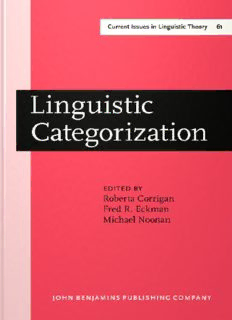
Linguistic Categorization: Proceedings of an International Symposium in Milwaukee, Wisconsin, April 10-11, 1987 PDF
Preview Linguistic Categorization: Proceedings of an International Symposium in Milwaukee, Wisconsin, April 10-11, 1987
LINGUISTIC CATEGORIZATION AMSTERDAM STUDIES IN THE THEORY AND HISTORY OF LINGUISTIC SCIENCE General Editor E.F. KONRAD KOERNER (University of Ottawa) Series IV - CURRENT ISSUES IN LINGUISTIC THEORY Advisory Editorial Board Henning Andersen (Buffalo, N.Y.); Raimo Anttila (Los Angeles) Thomas V. Gamkrelidze (Tbilisi); Hans-Heinrich Lieb (Berlin) J. Peter Maher (Chicago); Ernst Pulgram (Ann Arbor, Mich.) E.Wyn Roberts (Vancouver, B.C.); Danny Steinberg (Tokyo) Volume 61 Roberta Corrigan, Fred Eckman and Michael Noonan (eds) Linguistic Categorization LINGUISTIC CATEGORIZATION Edited by ROBERTA CORRIGAN, FRED ECKMAN and MICHAEL NOONAN JOHN BENJAMINS PUBLISHING COMPANY AMSTERDAM/PHILADELPHIA 1989 Library of Congress Cataloging-in-Publication Data Linguistic categorization / edited by Roberta Corrigan, Fred Eckman, and Michael Noonan. p. cm. ֊- (Amsterdam studies in the theory and history of linguistic science. Series IV, Current issues in linguistic theory, ISSN 0304-0763; v. 61) Bibliography: p. Includes index. 1. Categorization (Linguistics) I. Corrigan, Roberta. II. Eckman, Fred R. III. Noonan, Michael (Michael P.) IV. Series. P128.C37L56 1989 401' .43~dc 20 89-15193 ISBN 90 272 3558 9 (alk. paper) CIP © Copyright 1989 - John Benjamins B.V. No part of this book may be reproduced in any form, by print, photoprint, microfilm, or any other means, without written permission from the publisher. CONTENTS Preface vii Introduction: Linguistic and non-linguistic categorization: Structure and process 1 R. Corrigan I. Prototype effects in language 29 A lexical model of color space 31 J. Archibald Preliminaries to a theory of phonological substance: The substance of sonority 55 G. Nathan Categorizing phonological segments: The inadequacy of the sonority hierarchy 69 D. Maisch & R. Fulcher Experimental evidence for syllable-internal structure 81 M. Dow & B. Deriving Phonological categories and constituents 93 G. Iverson & D. Wheeler Are thematic relations discrete? 115 B. Rozwadowska Category restrictions in markedness relations 131 J. Gundel, . Houlihan & G. Sanders The acquisition of the past participle: Discourse-based vs form-based categories 149 C. Moder II. Categorization processes 161 Category learning in a connectionist model: Learning to decline the German definite article 163 R. Taraban, J. McDonald, & . MacWhinney vi CONTENTS Competition and lexical categorization 195 B. MacWhinney III. Cross-linguistic categorization 243 A discourse approach to the cross-linguistic category 'Adjective' 245 S. Thompson Pronominality: A noun-pronoun continuum 267 N. Sugamoto On Humboldt on the Dual 293 F. Plank Index of names 335 Language Index 343 Subject Index 347 PREFACE On April 10-11 1987, the Sixteenth Annual University of Wisconsin- Milwaukee Linguistics Symposium was held on the U.W.M. campus. This volume represents a selection of the papers presented at this symposium. The volume also contains contributions which were solicited from authors who did not attend the conference, but whom we believed had something to add to the volume. The paper by Sandra Thompson, one of the invited speakers for the symposium, has appeared elsewhere, and is reprinted here with permission. As always, the U.W.M. Linguistics Symposium is a collective endeavor with many sponsors. Those units supporting this year's conference include: The College of Letters and Science The Graduate School Master of Arts in Foreign Language and Literature The School of Education Department of Communication Department of Comparative Literature Department of German Department of Linguistics Department of Philosophy Department of Slavic Languages Department of Spanish and Portugese Department of Speech Pathology and Audiology To all of these units, we gratefully acknowledge their support. The objectives of the symposium were to address two fundamental questions: (1) What is the nature of the categories that underlie the struc tures of human language; and (2) what is the nature of the extrahnguistic categories that are reflected in language? The papers in this volume address these questions from the perspective of a variety of disciplines, using many different methodologies, and focusing on many different aspects of lan- Viii PREFACE guage including morphology, syntax, semantics, phonology and discourse. Following the introductory chapter, the volume is divided into three sec tions: Prototype effects in language, categorization processes, and cross-lin guistic categorization. We hope that our colleagues in Linguistics, Psycholinguistics, and Psychology will find the papers in the volume useful. Roberta Corrigan Fred Eckman Michael Noonan INTRODUCTION LINGUISTIC AND NON-LINGUISTIC CATEGORIZATION: STRUCTURE AND PROCESS1 ROBERTA CORRIGAN University of Wisconsin-Milwaukee A major debate in Linguistics, Philosophy, and Psychology concerns the nature of the relationship between language and thought. The position accepted by many linguists (e.g., Chomsky 1980) is that language and other cognitive systems require separate mental faculties. The hypothesized lan guage faculty is defined by Chomsky (1986:xxvi) as "the innate component of the mind/brain that yields knowledge of language when presented with linguistic experience." The language faculty is believed to have specific, unique characteristics that place universal constraints on the form that lan guage can take across cultures. An alternative point of view is that cogni tions (thoughts, intentions, and meanings) and the underlying cognitive structures and operations that direct those cognitions are responsible for language (Cromer 1974:234; 1976). Many cognitive scientists who work at modeling systems of knowledge seem to assume that language is, by defini tion, a cognitive faculty and therefore operates via the same general cogni tive processes that govern other cognitive faculties (for example, Anderson 1983, Schank & Birnbaum 1984, Winograd 1983). In this paper, I address the relationship between language and cogni tion by looking at a fundamental human ability, categorization. Although the present volume is devoted to 'linguistic categorization', categorization in language probably bears systematic relationships to categorization in other cognitive domains. I will therefore examine the structure of human categories, both linguistic and non-linguistic, and the process by which those categories may be formed to determine whether the same mental
Description: